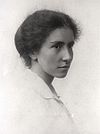- Creswellian culture
-
The Creswellian is a British Upper Palaeolithic culture named after the type site of Creswell Crags in Derbyshire by Dorothy Garrod in 1926.[2] It dates to between c. 12,500 and 12,000 BP (uncalibrated) and was replaced by the Mesolithic Maglemosian culture.
History
The Creswellian appeared for the first time in 1926 under the pen of Dorothy Garrod in The Upper Palaeolithic Age in Britain. This is the first academic publication[3] of the woman who became in 1939 the first woman ever elected as a professor at Oxbridge.[4] It is also the first monograph about the Upper Paleolithic of Britain at the national level and it remained the only one on the subject for half a century. In this study, Dorothy Garrod is led to consider that the British variant of the Magdalenian industry is different enough to create a specific name:[3]
"I propose tentatively "Creswellian", since Creswell Crags is the station in which it is found in greatest abundance and variety."— Dorothy Garrod, The Upper Palaeolithic Age in Britain, Oxford, Clarendon Press, 1926, p. 194.The definition of Creswellian was refined since then and now refers exclusively, in the British context, to the Late Magdalenian-style industry. However, its relevance is questioned by those who, like Jacobi and Pettitt, prefer to absorb the Creswellian in the Late Magdalenian.[3][5].
Description
It has parallels with the Federmesser and Hamburgian cultures of today northwestern continental Europe and the Magdelanian culture of southern Europe. The diagnostic tools are trapezoidal backed blades called Cheddar points and variant forms known as Creswell points as well as smaller bladelets. Other tool types include end scrapers made from long, straight blades. A special preparation technique was employed to remove blades from a core through striking in a single direction, leaving a distinct 'spur' on the striking platform. The tools were made using a soft hammerstone or an antler hammer.
Other finds from Creswellian contexts include Baltic amber, mammoth ivory and animal teeth and bone. These were used to make harpoons, awls, beads and needles. Unusual bevelled ivory rods, known as sagaies have been found at Gough's Cave in Somerset and Kent's Cavern in Devon.
Twenty eight sites producing Cheddar points are known in England and Wales though none have so far been found in Scotland or Ireland, regions which it is thought were not colonised by humans until later. Most sites are caves but there in increasing evidence for open air activity and that preferred sources of flint were exploited and that tools travelled distances of up to 100 miles from their sources. Some of the flint at Gough's Cave came from the Vale of Pewsey in Wiltshire whilst non-local seashells and amber from the North Sea coast also indicate a highly mobile population. This matches evidence from the Magdelanian cultures elsewhere in Europe and may suggest that exchange of goods and the sending out of specialised expeditions seeking raw materials may have been practised. Analysis of debitage at occupation sites suggests that flint nodules were reduced in size at source and the lighter blades carried by Creswellian groups as 'toolkits' in order to reduce the weight carried.
Comparison of flint from Kent's Cavern and Creswell Crags has led some archaeologists to believe that they were made by the same group.
Food species eaten by Creswellian hunters focused on the wild horse (Equus ferus) or the red deer (Cervus elaphus), probably depending on the season, although the arctic hare, reindeer, mammoth, Saiga antelope, wild cow, brown bear, lynx, arctic fox and wolf were also exploited.
Highly fragmentary fossil bones were found in Gough's Cave. They had marks that suggested actions of skinning, dismembering, defleshing and marrow extraction. The excavations of 1986-1987 noted that human and animal remains were mixed, with no particular distribution or arrangement of the human bones. They also show the signs of the same treatments as the animal bones. These findings were interpreted in the sense of a nutritional cannibalism. However, slight differences from other sites in skull treatment leave open the possibility of elements of ritual cannibalism.[6]
References
- ^ The museum's exhibit label says "Cresswell points were probably hafted knife blades", Derby Museum, read July 2011
- ^ Davies et al, William (1999). Dorothy Garrod and the progress of the Palaeolithic: studies in the prehistoric archaeology of the Near East and Europe. Oxbow Books. pp. 282.
- ^ a b c Kathryn Price « One vision, one faith, one woman: Dorothy Garrod and the Crystallisation of Prehistory », in Great Prehistorians: 150 Years of Palaeolithic Research, 1859-2009, London, Lythic Studies Society, 2009, p. 141-142.
- ^ Pamela Jane Smith, « From ‘small, dark and alive’ to ‘cripplingly shy’: Dorothy Garrod as the first woman Professor at Cambridge », University of Cambridge, 2005. Accessed 6 juin 2011.
- ^ Roger Jacobi, « The Creswellian, Creswel and Cheddar », in N. Barton, A. J. Roberts, D. A. Roe (éd.), The Late Glacial in north-west Europe - Human adaptation and environmental change at the end of the Pleistocene (= CBA Research Report, n° 77), Londres, 1991 ISBN 1-872414-15-X, p. 128–140.
- ^ P. Andrews, Y. Fernández-Jalvo, « Cannibalism in Britain: Taphonomy of the Creswellian (Pleistocene) faunal and human remains from Gough's Cave (Somerset, England) », Bulletin of the Natural History Museum: Geology, n° 58, 2003, pp. 59-81 (doi:10.1017/S096804620300010X).
Categories:- Archaeological cultures
- Stone Age Europe
- Upper Paleolithic
- Collections of Derby Museum and Art Gallery
Wikimedia Foundation. 2010.


